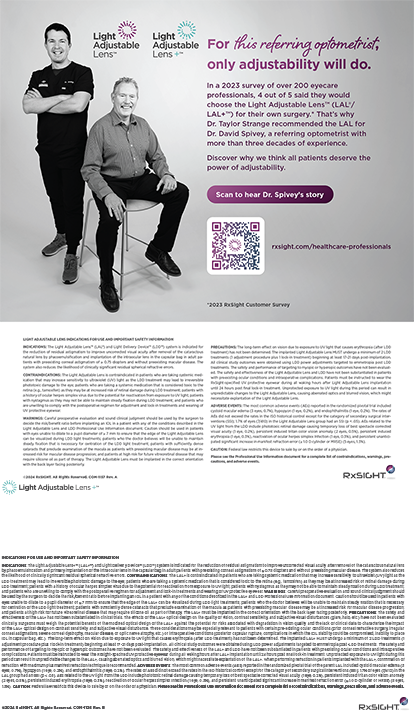Eleven years after you published your "Future Shock" article in the British Journal of Ophthalmology,1 how many of your predictions have come true?
I predicted that LASIK would affect three areas of ophthalmology: (1) calculating the power of IOLs; (2) accurately measuring IOP with the Goldmann applanation tonometer; and (3) the availability and suitability of donated corneas. All of these predictions have come true.
Fortunately, we ophthalmologists have adapted to the challenges posed by LASIK. Numerous methods and formulas consider LASIK's effect on the cornea when calculating the power of IOLs2-5 and thus minimize refractive surprises after cataract surgery. In addition, new tools such as the Pascal dynamic contour tonometer and the Ocular Response Analyzer obtain IOP measurements that are minimally influenced by post-LASIK changes in corneal biomechanics. Finally, eye banks can supplement clinical history and slit-lamp examination with ocular coherence tomography or videokeratography to screen donated corneas for signs of previous laser vision correction. It is important to identify these corneas, because they are not suitable for transplantation.
What qualities do IOLs need to possess before they can adequately replace the natural crystalline lens?
To replicate the qualities of a young crystalline lens, we need a polymer that has a similar refractive gradient and biomechanical properties. Although the currently available multifocal lenses are better than their predecessors, their performance is limited by decreased contrast sensitivity and photic phenomena. Conversely, accommodating lenses afford excellent contrast sensitivity but provide suboptimal near vision. Aspheric modifications to the lens' central optics may improve their function at close distances.
Dual-optic lenses, which are composed of a positively powered anterior optic connected to a negatively powered posterior optic via a spring haptic, have great promise, but they still must overcome the challenges created by fibrotic changes and anatomic variations in the capsular bag. Perhaps IOLs that change shape and alter their radius of curvature in response to the action of the ciliary muscle and that are designed for implantation in the sulcus will circumvent these limitations and produce a substantial accommodative reserve. These technologies, however, are still in the earliest phases of development.
What skills have you tried to instill in the clinical fellows you have trained during the past 20 years?
When I was a resident at the Wilmer Institute of the Johns Hopkins Hospital in Baltimore, the late A. Edward Maumenee, MD, told me that the ability to listen to your patients carefully is the most important skill an ophthalmologist can possess. This advice was reinforced by Michael Lemp, MD, when I was a corneal fellow at Georgetown University in Washington, DC. I believe that listening skills should be supplemented by strong observational abilities and surgical dexterity.
What is the secret to incorporating research into a busy clinical practice?
High-quality clinical research requires tremendous discipline, organization, and administration as well as a talented, dedicated team of people. You must also commit financial resources (ie, hire a study coordinator) and be passionate about science, medicine, and helping people. You must truly enjoy the process, because it requires a lot of time, effort, and sacrifice. If you have an inquiring mind, enjoy writing, and like applying the scientific method to testable hypotheses, you can conduct serious research studies, even in a busy clinical practice. The outcomes can be truly rewarding and exciting.
What are your interests outside of ophthalmology?
I enjoy spending time with my children. My oldest son just graduated from college, and I have 13-year-old triplets (two boys and a girl) who are discovering their individual talents and passions. I also like to travel with my wife (my college sweetheart of 34 years). We took our family to the Galapagos Islands last year and to Israel this past spring. Iceland is next on our list!


